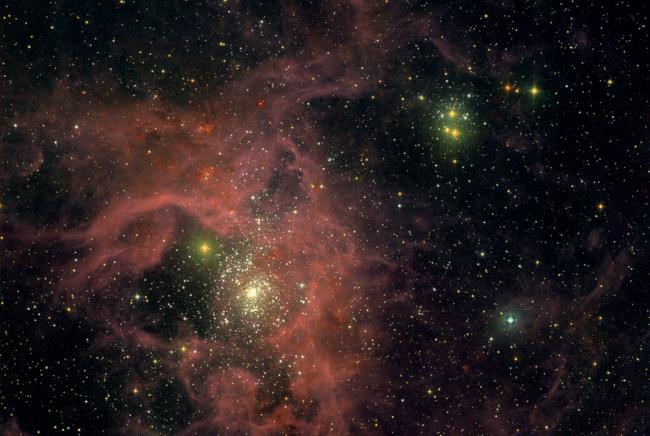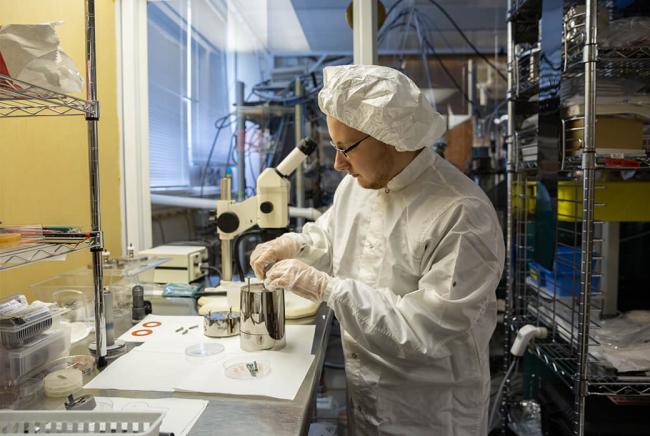Instrumentation
Learning about the universe and its contents requires the right tools. Much of research is about creating those tools: new telescopes, detectors, spectrographs, and other instruments needed to see farther and clearer than ever. Developing instrumentation is an essential part of research, involving astronomy, physics, materials science, and engineering.
Our Work
Every aspect of modern astronomy relies on technology. The job of a telescope is to focus light, but it’s the job of instrumentation to turn that light into something scientists can use. These instruments collect light, split it into its component colors, count photons, and capture particles. Each telescope, detector, and probe requires its own particular instrumentation, sometimes with multiple instruments to handle different aspects of observation.
The Center for Astrophysics (CfA) has developed instrumentation for many telescopes, space probes, and other projects. These instruments are useful not just to researchers within Harvard and the Smithsonian, but to the community of astronomers around the world. Next-generation instruments will lead to discoveries that will shape research in the future.
-
Cameras for visible light and infrared telescopes are particularly large and sensitive versions of ordinary digital cameras. They are designed to take in a particular amount of light using a shutter, and record that light using electronic chips. CfA researchers designed cameras for the MMT telescope in Arizona, the Magellan Telescopes in Chile, and other major observatories.
-
In addition to taking images, astronomers use devices known as spectrographs to split light from distant objects into its component colors. This helps identify chemical composition, temperature, and velocity of the light source. CfA instrumentalists have constructed spectrographs for a number of observatories, including the MMT and Magellan telescopes. The GMT-Consortium Large Earth Finder (G-CLEF) is a current CfA project, designed for the next-generation Giant Magellan Telescope (GMT) under construction in Chile.
-
Certain observations require additional precision in finding the spectrum of light. For that, researchers use frequency combs, also known as astro combs. These devices split laser light into very specific colors, which can be used to improve spectrographic measurements. CfA researchers provided astro combs to the HARPS observatories in Chile and the Canary Islands.
-
Earth’s atmosphere blocks much of the high-energy light from the Sun and other astronomical sources. For that reason, telescopes designed to study ultraviolet light, X-ray, and gamma rays fly on high-altitude rockets and balloons, or on spacecraft. Smithsonian scientists developed the High Resolution Camera for NASA’s Chandra X-ray Observatory, one of the major space telescopes. Chandra’s flight and science operations are managed at the Center for Astrophysics.
-
CfA researchers contributed to the development of the Infrared Array Camera (IRAC) aboard NASA’s Spitzer Space Telescope, one of the world’s premier infrared space observatories.
-
Researchers at the CfA developed instrumentation for observing the Sun. These projects include the X-Ray Telescope (XRT) aboard the Japanese Space Agency’s Hinode solar observatory, as well as Atmospheric Imaging Assembly (AIA) ultraviolet instruments for NASA’s Solar Dynamics Observatory (SDO). AIA captures IMAX-resolution images of the entire Sun every ten seconds in ten different wavelengths of ultraviolet light.
-
Not all astronomy and astrophysics involves light. The Parker Solar Probe will pass through the Sun’s atmosphere, allowing the Solar Wind Electrons Alphas and Protons (SWEAP) detector to collect particles for study. CfA researchers helped with the testing process to prepare the solar probe for launch.

Sagi Ben-Ami, Juliana Garcia-Mejia, and Surangkhana Rukdee at work on the GMT-Consortium Large Earth Finder (G-CLEF). This high-precision instrument will be used on the Giant Magellan Telescope to find Earth-like planets.

The Tarantula Nebula in the Large Magellanic Cloud is a huge star-forming region. The MMT and Magellan Infrared Spectrograph (MMIRS) on CfA's MMT Observatory allows astronomers to study such regions in detail.

Drew Ames works in Suzanne Romaine's lab at the Center for Astrophysics | Harvard & Smithsonian.
- Astro Combs
- Planetary Atmospheres
- Spectroscopy
- Telescopes
- Cosmic Microwave Background
- Detector Technology
- Exoplanets
- Very Long Baseline Interferometry
Related News
Giant Magellan Telescope Mount Fabrication Begins
The Giant Magellan Telescope’s Final Mirror Fabrication Begins
New Horizons in Physics Breakthrough Prize Awarded to CfA Astrophysicist
Sheperd Doeleman Awarded the 2023 Georges Lemaître International Prize
Incoming Postdoc, Outgoing Grad Awarded 51 Pegasi B Fellowships
Astronomers Warn of Risk of Misinterpreting JWST Planetary Signals
$205 Million Investment Accelerates Construction of the Giant Magellan Telescope
'The Dawn of a New Era in Astronomy'
Astronomers Reveal First Image of the Black Hole at the Heart of Our Galaxy
Bringing Black Holes to Light
Projects
AstroAI
GMACS
For Scientists
The Galileo Project
Telescopes and Instruments
BICEP
Visit the BICEP Website
Giant Magellan Telescope
Visit the GMT Website
Magellan Telescopes
Visit the Magellan Telescopes Website
MMT Observatory
Visit the MMT Website